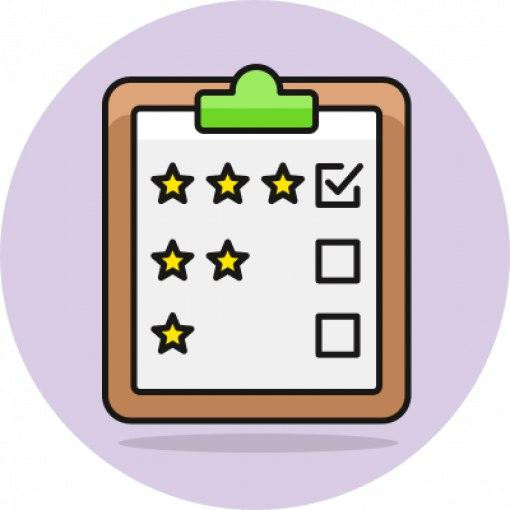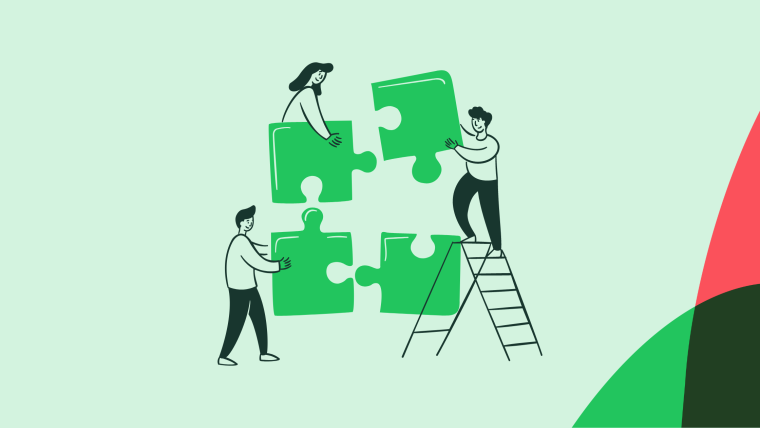You make a lot of decisions every day. Some of them are easy, while others make a huge impact on your business direction and require a thorough understanding of the options at stake.
To build new software in-house or buy a no-code SaaS solution is one of the decisions you don’t want to rush. The solution you choose needs to align with your vision, product roadmap, and both short-term and long-term goals.
We encourage you to put everything on (virtual) paper and consult your whole team – execs and stakeholders included.
There are various decision-making frameworks that can help you (we’ll dig into these later on), but you can also think of this guide as a framework of its own.
We’ll cover three key factors to take into consideration – the problem you want to solve, the resources you have/need, and the overall cost. We’ll go step-by-step through possible scenarios, options, and questions for each.
Plus, we prepared a useful summary with brainstorming templates you can share with your team to make it easier for everyone to follow. Download it right here 👇
To build or to buy?
Download our guide with brainstorming templates, pros and cons for each solution, and an overview of decision-making frameworks. We’ll send it straight to your inbox.
Build vs. Buy: How to decide?
When we say “build vs. buy” in relation to new software you might need, we talk about evaluating two options:
Building software in-house
Buying a no-code SaaS solution
What is the difference? Each of these will set you on a different path of further steps to take, options to consider, and evaluations to make.
If you decide to build software in-house, you’ll need to assess the current state of people power, to begin with. Is your development team ready for it? Do your engineers have the right skills and enough time to dedicate to this new project? Would you need to hire freelance software developers? When can you expect to get a fully functional system?
If you decide to buy software, you’ll need to start by answering questions about the discovery and evaluation. Do you know what type of SaaS software you’re looking for? What are the must-have features? Are there the right integrations available?
That’s a lot of questions to answer. So let’s break it down into manageable steps.
Here, we’ll walk you through three key factors you need to consider, and we’ll go into details for each. To ease your decision-making process, we’ll go through possible scenarios, along with several options for different situations.
And here’s the brainstorming template that can help you keep track and answer the right questions along the way.

The problem: What do you want to solve?
Why do you need new software, and why now?
What problem(s) are you going to solve with it?
What goals do you want to accomplish?
Start with the why – why do you need new software, why now?
Proceed with the goals you want to achieve with the new software. For example, goals can include:
Gain of competitive advantage by offering something completely new
Expansion to new markets/verticals or new audiences
Adjustment to ever-evolving market trends
Increase of your retention rates and overall customer satisfaction
When you have a clear understanding of the problem you want to solve, the level of urgency, and the goals you want to accomplish, it will be easier for you to decide.
Let’s look into a couple of possible scenarios.
Scenario 1: Alarming churn rate
You need to fix a product adoption problem that you’ve noticed recently – there’s an alarming increase in churn rates. You conducted your analysis and identified unclear UX as the problem that makes users get stuck and frustrated.
In this scenario, we’d recommend you purchase a software solution that helps you make improvements and start seeing the results before it’s too late.
This would be the right fit especially if your product already integrates with customer data platforms (CDPs) and product analytics tools. In this case, you could implement a Digital Adoption Platform (DAP) – such as Chameleon – to offer in-product tours, guides, and tooltips at the exact place and time where your users need them.
Combined with the data for other tools you’re using, this could make a big impact on your customer satisfaction, adoption, and retention rates. And, most importantly, you'll see the results quickly.
If you urgently need to reduce churn and are using Segment, installing Chameleon is the quickest way to increase user engagement. Simply activate the integration in both products and copy over the API key, and you can immediately start deploying Experiences that will increase feature adoption.
For Product Marketers and CSMs with scarce time or engineering resources, this no-code solution provides results quickly and autonomously. That’s how The Motley Fool reduced churn by 9% in 45 days.
Even if you’re not using Segment there are other low-code installation methods: using Google Tag Manager, npm, or JavaScript. Because Chameleon is designed to work with your product infrastructure and integrations, it’s the no-compromise “buy” option for agile teams.
Scenario 2: Overwhelming amount of support tickets
Your company is experiencing rapid growth, but it also means that your CS team needs to handle more support tickets daily (as quickly as possible).
In this case, you have two options:
Option 1: Build a custom ticketing platform and bring more people into your Customer Support team to address all the issues on time – via email, phone, social media, and other channels. You can implement a chatbot to offer real-time support, too. But, remember, if your team members are available for chat only at a given time, be transparent about it. Otherwise, you risk losing hard-earned trust.
Option 2: Implement a DAP and offer self-serve support as an additional layer on top of your onboarding flow, product tours, and in-app guides to help users find the answers and learn how to use your product at their own pace. This is especially important if you run a product-led company, or if your product has a steep learning curve.
All in all, make sure you solve relevant problems. You can also use some of the problem-solving frameworks to help you identify problems and make better-informed decisions.
The option you choose will depend on your company size, the resources you have at your disposal, current processes and software you’re using, as well as your product vision and investment plans.
This brings us to the second key factor – the resources.
The resources: What will you need to accomplish your goals?
Time
Budget
Team
Tools
Methodology
Scope
To start solving your “build vs. buy” dilemma, you’ll need to assess the current state of resources at your disposal and decide what you need to build/implement to be able to achieve your goals, both short-term and long-term.
Here are some of the main resources you’ll need to assess to be able to accomplish your goals effectively.
Time: Estimate how much time it will take to build a functional system in comparison to the time needed to evaluate existing solutions. Is a custom solution going to fit into a reasonable time frame? On the other hand, software development takes time. Think carefully about whether your engineering team has the availability to work on an in-house solution.
Budget: Many companies don’t have an allocated budget for building enterprise-level software in-house. Sometimes it can be easier to justify monthly recurring payments or an annual investment for SaaS license fees. In fact, these investments are continually growing. According to Statista, worldwide spending on enterprise software is expected to amount to $672 billion in 2022, and surpass $750 billion in 2023.
Team: Depending on your team size and structure, as well as future hiring plans, estimate whether you’ll have the core team with the right skillset – engineers, designers, PMs. Consider a wider team of UX writers, product marketers, and growth managers, too. Is it going to be easy to get the buy-in from stakeholders?
Tools: This regards your existing systems, automation, repositories, partner ecosystem, and overall core competencies. Will your existing tools integrate well with the new software? Are there any security risks? Does a SaaS vendor you’re evaluating provide a specialized solution with cutting-edge technology?
Methodology: Depending on your underlying business methodology, this is where you assess whether you already have the needed standards, policies, and guidelines in place. Is your product roadmap flexible enough? Are your developers dealing with technical debt? Will the new custom software add more struggles for them?
Scope: Whether you decide to build or to buy, it is going to be a new project for your team. Evaluate the overall scope of this project, including the planning sessions, workflows, internal communications, and meetings. Add the goals, strategies, and specific tasks to the equation, too.
This stage of your “build vs. buy” journey is about closing the gap between the current state and the ideal future state.
Once again, document what you already have and start planning. Identify resources, core competencies, and activities required to bring the project to life. Is the new software solution going to bring you a strategic advantage?
Don’t forget to include user feedback in the process, too. After all, you’re developing a new solution that your customers will benefit from. The best way to gather meaningful feedback is to run in-product surveys to ask existing customers what they think and need.

Run product surveys with Chameleon
In-app Microsurveys allow you to capture important user feedback when it's most relevant
The cost: When can you expect to see ROI?
How much will it cost?
Is it a cost-effective solution?
How long before the time to value?
Are there any hidden costs?
For both of the solutions – custom development and a third-party solution – list all the items, issues, resources, processes, and anything else that might have a price tag attached to it.
Then, calculate the overall sum and estimate when you’ll see tangible results and actual return on investment (ROI). Does it fit your budget? What if it goes over budget?
Think upfront about all the possible hidden costs that you can come across later. This can include ongoing maintenance costs, unexpected issues, extended development/evaluation time, ongoing support costs, and more.
Do your research and gather the results to provide a foundation for understanding the current state and what you want to accomplish in the future. Invite others into the process.
Use collaborative methods to increase buy-in and ownership, and consider a wide set of opinions and insights. Be sure to create a separate plan for each solution to make it easier for everyone to follow.
Pros & Cons: The main points you should consider
Both in-house development and implementation of a SaaS platform have their pros and cons. Take these into consideration for your “build vs. buy” decision, too.
The Pros and Cons of building in-house
Pros:
A custom-built platform
The solution solves a complex problem
It fits the context of your company
You have full control over the solution
Cons:
Can take a lot of time and resources
Can be a costly solution
Can go over the initial budget
Can have additional maintenance costs
The Pros and Cons of buying software
Pros:
Easy setup
Quick results
Try before you buy
No dev time needed
No coding skills required
Integrates with your tech stack
Specialized focus on the problem you want to solve
Continuous improvement and room to grow
Cons:
Can take time to evaluate existing solutions: If you want to solve a common issue, there are likely many existing solutions out there. Look for the ones with a dedicated focus on your purpose.
Might need additional installment and integrations: If there’s a mismatch between a new solution and existing software you’re using, you might need additional integrations. Make sure to understand how deep integrations are at the offer and how those can benefit your purpose.
The buying journey can take longer than expected: The process of evaluation and purchase of a B2B SaaS solution doesn’t happen overnight. It typically takes a few months, but it can take longer depending on how specific your use case is.
How to ensure you’re making the right decision
As we mentioned, making a “build vs. buy” decision can have an impact on your future business direction, so you don’t want to rush it.
Here are several decision-making frameworks that can help you make the right call.
The MoSCoW framework
This framework takes its name from the acronym M (Must have), S (Should have), C (Could have), W (Won't have). It’s one of the most common prioritization frameworks, used by product teams to understand the significance of the options at hand and prioritize features they want to build (or buy).
The MoSCoW consists of four categories:
Must-haves: Non-negotiable features
Should-haves: Important features
Could-haves: Nice-to-have features
Will-not-haves: Lower priority features
For the purpose of the “build vs. buy” decision, this framework can be useful in two ways:
If you use it to evaluate third-party solutions, use it in the evaluation process. It can help you prioritize features more quickly when you know exactly what are the must-haves and which features don’t add any value to your use case.
If you use this framework for a decision on custom development, it can help you estimate what skills engineers should have in order to build the must-have new features, and whether you need to hire more people.
Before using this framework, you need to align the product strategy, goals, and prioritization factors. You can then discuss how your team will settle any potential disagreements, and make product decisions by defining the resources to allocate to each category.

The Hierarchy of Purpose
This is the framework that can help you prioritize strategically. It was developed by Antonio Nieto-Rodriguez, co-founder of the Strategy Implementation Institute and the author of the HBR Project Management Handbook, as a way to help executives make better decisions.
As he described in the HBR article, the Hierarchy of Purpose takes into consideration:
Purpose: This is somewhat similar to the identification of the problem you want to solve with the new software and why you want to solve it. Here, you answer what the purpose of your project is, and what strategic vision it supports.
Priorities: With the stated purpose in mind, at this stage, you’ll answer what priorities your company has right now and what will be the most important over the next 2-5 years.
People: With clarity around the strategic priorities, focus on who are the best people to execute this project. For example, if you decide to build a mobile app, do you need to hire app developers, and does that fit into your plans?
Outcomes: The scope, time, and budget are mostly inputs. But make sure to also evaluate the outcomes such as benefits and impact. You can start by thinking about outcome-related targets that will measure performance and show the real value – both business value and the value for your customers.
This can help you make a decision whether to opt for custom software development or for purchasing an existing solution, all while focusing on the goals and outcomes you want to see.

The OODA loops
The OODA loop refers to the observe–orient–decide–act cycle, originally developed by a military strategist and the United States Air Force Colonel, John Boyd.
The framework relies on situational awareness, clear-cut plans, and decisions that need to be made in fast-moving scenarios. So, this framework can be really useful if you don’t have much time.
The four steps of the OODA loop are:
Observe: Understand the context, collect relevant data, and digest the information
Orient: Analyze, evaluate, and convert raw data into meaningful insights
Decide: Make a decision on the course of action to deliver the optimal outcome
Act: Execute your decision and determine whether your hypothesis was right
Action is not the last step, though. Using the OODA loops will help you move through the decision-making process – make smaller decisions quickly and take your learnings into consideration. Ideally, each next cycle will give you more accurate results, faster.

The verdict: To build or to buy, that is the question
The decision you make will depend on your goals, current state, and future plans. There’s no one-size-fits-all solution, but we hope you now have a better understanding of how to make the right decision.
Key takeaways:
Know your why – why do you need a new software solution?
Identify resources and activities required to accomplish your goals
Take all costs into consideration and estimate when you’ll see the ROI
Do your research and make a strategic, outcome-based plan
Share insights with your team and get clear on everyone’s involvement
To sum it up, here’s our verdict.
Build in-house if your current resources (team, processes, time) allow you to do so without making additional investments. This can also be the right fit for you if your budget allows you to hire more people who will dedicate their time to building this new product.
Custom in-house development can be the best solution for you if you need to solve a complex problem within the specific context of your company. Also, if your use case would be on the edge of what existing solutions can solve.
Opt for a no-code solution if your development team is already overwhelmed with the number of core features to work on in the future and you don’t plan to hire new people soon. This can be the most cost-effective solution, especially if your budget is tight.
It can also be the fastest way to solve specific problems at specific stages of your product lifecycle, like alarming churn rates, onboarding friction points, feature adoption decrease, support ticket deflection, and more.
Integrating a SaaS tool with your existing tech stack can ease user feedback collection and product data analysis. This way, you’ll quickly see the results and be able to accomplish your goals sooner.

Boost Product-Led Growth 🚀
Convert users with targeted experiences, built without engineering





